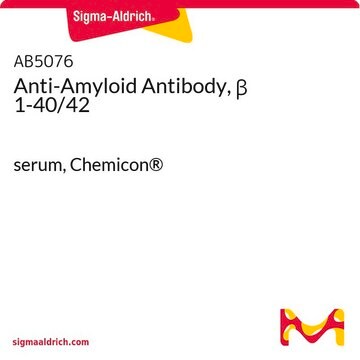MABN819
Anti-Tau Antibody, oligomeric Antibody, clone TOMA-1
clone TOMA-1, from mouse
Sinónimos:
Microtubule-associated protein tau oligomer, Tau oligomer, PHF-tau oligomer, Paired helical filament-tau oligomer, Neurofibrillary tangle protein oligomer
About This Item
Productos recomendados
origen biológico
mouse
Nivel de calidad
forma del anticuerpo
purified immunoglobulin
tipo de anticuerpo
primary antibodies
clon
TOMA-1, monoclonal
reactividad de especies
rat, human, mouse
reactividad de especies (predicha por homología)
mammals (based on high homology)
técnicas
ELISA: suitable
dot blot: suitable
immunofluorescence: suitable
immunohistochemistry: suitable
neutralization: suitable
western blot: suitable
isotipo
IgG2aκ
Nº de acceso NCBI
Nº de acceso UniProt
Condiciones de envío
ambient
modificación del objetivo postraduccional
unmodified
Información sobre el gen
human ... MAPT(4137)
mouse ... Mapt(17762)
rat ... Mapt(29477)
Descripción general
Especificidad
Inmunógeno
Aplicación
Neuroscience
Please refer to the following publications regarding the use of TOMA clones in Dot Blot, ELISA, Immunofluorescence, Immunohistochemistry, Neutralization, and Western Blotting applications:
1. Vuono, R., et al. (2015). Brain. 138(Pt 7):1907-1918.
2. Castillo-Carranza, D.L., et al. (2015). J. Neurosci. 35(12):4857-4868.
3. Castillo-Carranza, D.L., et al. (2014). J. Neurosci. 34(12):4260-4272.
Calidad
Western Blotting Analysis: 4 µg/mL of this antibody detected Tau oligmers in 25 µg of Alzheimer′s diseased human brain lysate.
Descripción de destino
Forma física
Almacenamiento y estabilidad
Otras notas
Cláusula de descargo de responsabilidad
Not finding the right product?
Try our Herramienta de selección de productos.
Código de clase de almacenamiento
12 - Non Combustible Liquids
Clase de riesgo para el agua (WGK)
WGK 2
Punto de inflamabilidad (°F)
Not applicable
Punto de inflamabilidad (°C)
Not applicable
Certificados de análisis (COA)
Busque Certificados de análisis (COA) introduciendo el número de lote del producto. Los números de lote se encuentran en la etiqueta del producto después de las palabras «Lot» o «Batch»
¿Ya tiene este producto?
Encuentre la documentación para los productos que ha comprado recientemente en la Biblioteca de documentos.
Nuestro equipo de científicos tiene experiencia en todas las áreas de investigación: Ciencias de la vida, Ciencia de los materiales, Síntesis química, Cromatografía, Analítica y muchas otras.
Póngase en contacto con el Servicio técnico








